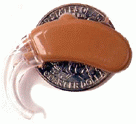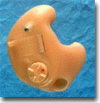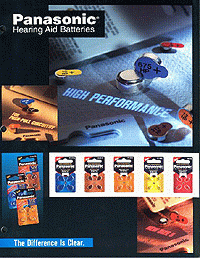|
Conventional Hearing Aids
The most basic type of hearing aids, conventional
hearing instruments are selected by your hearing professional so
that the hearing aid response best matches the client's hearing
loss at the time of testing. Volume adjustments can be made manually
by the client. If sounds are too soft, the volume can be "turned
up". If sounds are too loud, the client can "turn down" the volume
control.
Minor changes to the hearing aid sound can be made
by the hearing professional. Major changes or changes in the client's
hearing loss entail sending the hearing instrument back to the manufacturer
so that the response can be altered.
Conventional aids have a microphone to gather sound,
an amplifier to increase sound volume and a receiver to transmit
the amplified sound to the ear. These aids have a manual volume
control for the client. Screw-set controls are usually mounted on
the hearing aid for the hearing professional to adjust. The controls
handle the amplification and the frequency/tonality, and are adjusted
by the hearing professional.
Programmable Hearing Aids
Programmable hearing aids are a step up in technology
from conventional hearing aids.
These instruments have an analog circuit that can
be adjusted (programmed) on a computer by your hearing professional.
The greater flexibility available and fine-tuning allow much greater
control in matching the hearing aids to the client's needs. They
also feature automatic volume control.
Programmable hearing aids are selected by the hearing
professional by matching most closely the manufacturer and circuit
they think will work best for the client's hearing loss and lifestyle.
When the programmable instrument is received, it is connected to
a computer and the computer sets a listening program in the hearing
aid based on the client's hearing loss. While being fit with the
aids, the client reports likes/dislikes to the professional for
immediate changes . Since all people have different needs and hearing
losses, it can take a few follow-up visits to set the program to
the best match for the client's needs. Most programmable aids have
automatic volume control so the client needs only to wear the instruments
and listen.
If the client's hearing loss changes, adjustments
can be made in the program by the hearing professional in the office.
Many programmable aids are easy to wear and some automatically
adjust volume based on the level of the incoming sound. This circuitry
makes soft sounds louder and loud sounds softer. The microphone
gathers the sound information. The amplifier makes adjustments to
the sound based on the program set in the hearing aid by the professional.
The receiver (speaker) then transmits the altered sound to the ear.
Digital Hearing Aids
Digital hearing aids have the most advanced technology
available today. They are programmable hearing instruments with
digital circuits. The digital circuits are more flexible than analog
circuits. Precise programming to match the client's individual hearing
loss, sometimes at each specific frequency/pitch is available in
digital aids.
Improved clarity of sound, less circuit noise, faster
sound processing, and improved listening in noise are offered by
digital hearing instruments. Digital aids adjust volume automatically.
Digital hearing aids process sound digitally. The
sound you hear will be clear and free from distortion. Digital aids
allow the most precise prescriptive fitting available in hearing
instruments today. Older analog aids turned everything up, while
digital aids focus on bring understanding through sophisticated
control of the sound signal inside the hearing aid. Sounds differ
in pitch, volume/loudness which digital processing can shape across
changing pitches and volumes.
Due to changing hearing levels at different frequencies,
each specific frequency needs a different amplification. Digital
hearing aids separate the frequency response into bands and channels,
which can be manipulated independently, customizing the hearing
aid response to your specific hearing loss. They can examine the
sound environment and adapt the amplification accordingly without
adding noise or distortion.
Digital hearing aids compared to conventional hearing
aids is like comparing a compact disc to a record player.
Types of Hearing Aids
|
Behind-the-Ear: This kind of hearing aid fits behind
the ear and carries sound to the ear through a custom ear
mold. Hearing aids that are attached to eyeglasses are a type
of behind-the-ear hearing aids. They are useful for mild to
severe hearing loss.
|
 |
|

|
In-the-Ear: These are custom made to fit in the outer
ear. You can't see any wires because they are inside the aid.
They are useful for mild to moderate hearing loss.
|
|
Completely-in-the-Canal: This kind of hearing aid
is custom made to fit in the ear canal. There are no outside
wires or tubes. These hearing aids are almost impossible to
see. They help people with all but the worst hearing loss.
|
 |
| On-the-Body: These are for
very bad hearing loss. They include a case with a larger microphone,
amplifier and battery. The case can be carried in pockets or
attached to clothing. The case is connected by a wire to an
ear receiver that is attached to an ear mold. |
 |
National Heairng Center provides all sizes
and brands of hearing aid batteries. Just send us an email
stating size, quantity, payment info and shipping address.
We will be happy to send them out to you that day.
Only 79 Cents per battery plus
55 Cents for shipping and handling!
E-mail
for more information
|
|




